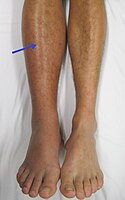
Photo from wikipedia
BACKGROUND The clinical utility of warfarin dose prediction algorithms remains controversial, our purpose is to evaluate the performance of warfarin dose prediction algorithms and the effects of clinical factors on… Click to show full abstract
BACKGROUND The clinical utility of warfarin dose prediction algorithms remains controversial, our purpose is to evaluate the performance of warfarin dose prediction algorithms and the effects of clinical factors on warfarin dose in Chinese patients. METHODS Clinical data of 217 patients who received warfarin treatment were used to assess 6 warfarin dose prediction algorithms (OHNO, IWPC [International Warfarin Pharmacogenetics Consortium], HUANG, KIM, BRESS, and MIAO). The predicted dose (PD) was compared with the warfarin optimal dose (WOD, defined as the dose that maintains the international normalized ratio within the target range of 2.0-3.0). A multiple regression analysis with WOD as the dependent variable was performed to evaluate the effects of clinical factors on warfarin dose. RESULTS The mean absolute error analysis ranked the predictive accuracies of the algorithms as OHNO > IWPC > HUANG > KIM > BRESS > MIAO. Stratified analysis indicated that HUANG most accurately predicted that patients required lower WODs (≤3 mg/d), whereas OHNO was the most effective in predicting medium WODs (3-5 mg/d). KIM was effective in predicting high WODs (>5 mg/d). Multiple linear regression analysis showed that VKORC1 (rs9923231) and body mass index were significantly positively correlated with WOD, whereas concurrent atrial fibrillation status, CYP2C9*3 (rs1057910), and sex were significantly negatively correlated with WOD. CONCLUSIONS In Chinese patients, OHNO should be given priority during the prediction and selection of warfarin dose. When using OHNO to predict warfarin dose (≤3 mg/d or >5 mg/d), HUANG or KIM algorithms can provide precise predictions. At the same time, physicians should pay close attention to clinical factors, such as VKORC1 (rs9923231), concurrent atrial fibrillation status, CYP2C9*3 (rs1057910), body mass index, and sex, to improve warfarin dose adjustment strategies in Chinese patients.
Journal Title: Therapeutic drug monitoring
Year Published: 2021
Link to full text (if available)
Share on Social Media: Sign Up to like & get
recommendations!